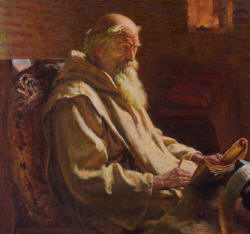
The Historical Works Of Venerable Bede
CHAPTER II
OF THE SEPULCHRE OF OUR LORD, OF THE CHURCHES OF CONSTANTINE AND GOLGOTHA, AND OF THE OTHER HOLY PLACES IN JERUSALEM
WHEN you have entered the city on the northern side, first of the Holy Places, as regards the order of the streets, you must turn out of the way to see the Church of Constantine, which is called: The Martyrdom. It was built in the most magnificent and princely style by the Emperor Constantine, to commemorate the finding of our Lord’s cross in this place by his mother Helena. To the west of this is seen the Church of Golgotha, where too may be seen the rock which formerly bore the very cross that was fastened to our Lord’s body; but which now bears a very large silver cross, and a great wheel of brass hangs from above with lamps. Under the place of our Lord’s cross, a vault is hewn out of the rock, in which sacrifice is offered on an altar for honourable persons deceased, their bodies remaining meanwhile in the street. To the westward of this is the Anastasis, that is, the round church of our Saviour’s resurrection, encompassed with three walls, and supported by twelve columns. Between each of the walls is a broad space, containing three altars at three different points of the middle wall, on the north, the south, and the west. It has eight doors or entrances through the three opposite walls; four whereof front to the north-east, and four to the south-east. In the midst of it is the round tomb of our Lord cut out of the rock, the top of which a man standing within can touch; the entrance is on the east; against it is laid that great stone, which to this day bears the marks of the iron tools within, but on the outside it is all covered with marble to the very top of the roof, which is adorned with gold, and bears a large golden cross. In the north part of the monument is the tomb of our Lord, hewn out of the same rock, seven feet in length, and three palms above the floor; the entrance being on the south side, where twelve lamps burn day and night, four within the sepulchre, and eight above on the right-hand side. The stone that was laid at the entrance to the monument, is now cleft in two; the lesser part of it stands as a square altar before the door of the monument; the greater part makes another square altar in the east part of the same church, and appears under the linen cloths. The colour of the said monument and sepulchre appears to be white and red. Attached to this church on the right side is the square church of the blessed Mother of our Lord. In the street which unites the Martyrdom and the Golgotha is a seat, in which is the cup of our Lord concealed in a casket. It is touched and kissed through a hole in the covering. It is made of silver, has two handles, one on each side, and holds a French quart. In it also is the sponge which was used to minister drink to our Lord. But where Abraham built an altar whereon to sacrifice his son, there is a large wooden table on which the people lay alms for the poor. All these particulars, which I have here mentioned, I have endeavoured to render more intelligible by the following picture.
(The drawing is wanting in the Manuscripts.)
The soldier’s lance also is kept inserted in a wooden cross, in the portico of the Martyrdom, and its shaft, which has been broken in two pieces, is an object of veneration to the whole city.
Copyright ©1999-2023 Wildfire Fellowship, Inc all rights reserved

 Keep Site Running
Keep Site Running